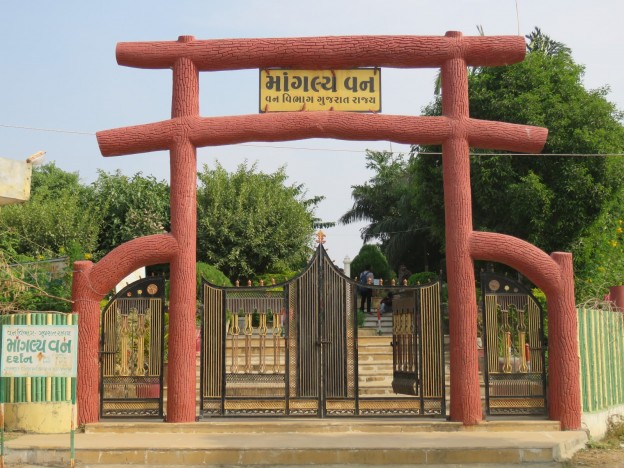Park/Zoo
Sabarmati River Front
A resurrection of the cityscape and the river Sabarmati in 2005 led to the making of the Sabarmati Riverfront, a 22km planned promenade of which only a part is now complete. Boating stations and pop-up exhibition spaces are built along the river, but it is the fitness enthusiasts who do due justice to the path on daily walks and jogs.
Eleven bridges built over the Sabarmati River connect the old and new parts of the city. Of these, the Ellis Bridge is the oldest – built in 1873. It was a wooden structure that was destroyed by a flood but re-constructed for use. Other bridges include Gandhi Bridge, Nehru Bridge, Subhash Bridge, Vadaj – Dudheshwar Bridge, Sardar Bridge, Chandrabhaga Bridge, Ambedkar Bridge (Vasna Pirana Bridge), Lal Bahadur Shastri Bridge, Fernandes Bridge and the Dandi Bridge.
Flower garden has been envisioned as a permanent flower garden spread in Approx 45000 Sqmt where more than 330 native and exotic flower species. Throughout the year, the garden serves as a city level unique park where visitors can enjoy beautiful flowers of both seasonal and non seasonal varieties. It strengthens the green space network on the western park of the city.
Brief History: The Sabarmati River has been the lifeline of the city of Ahmedabad for centuries. The river was given a prominence when the city went through an urban overhaul in 2005. The riverfront was made an integral part and opened for the public to enjoy a corniche-like walkway.
Sunrise to Sunset
Ahmedabad
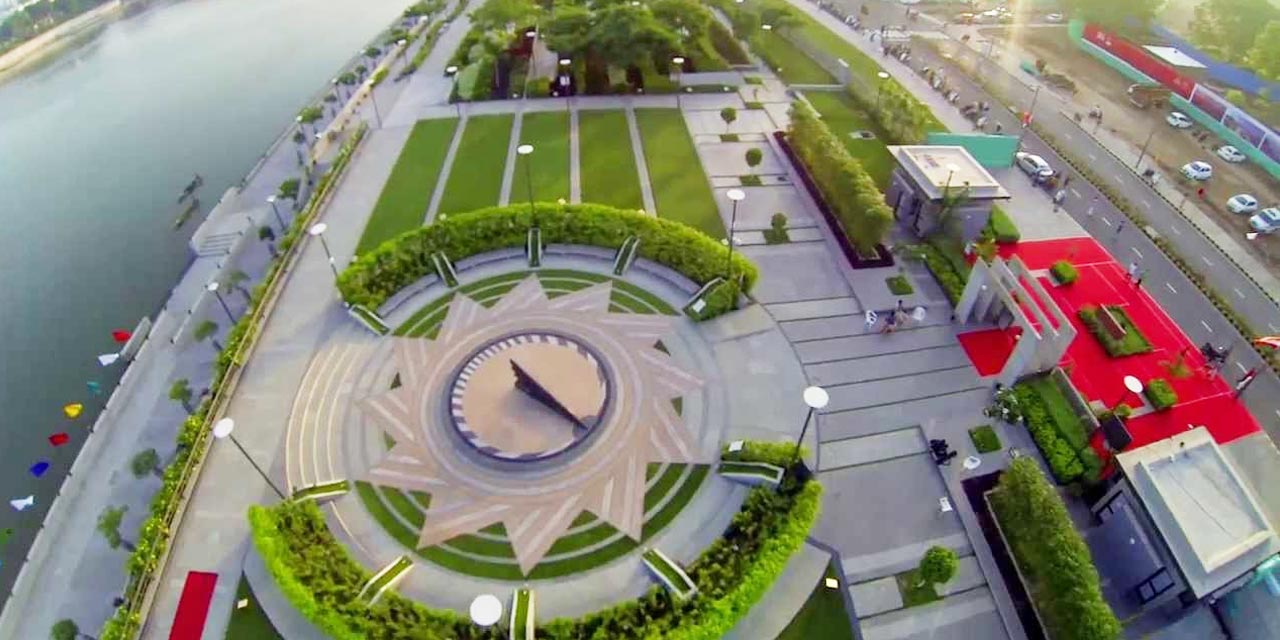

Sayaji Baug
Sayaji Baug, also known as Kamati Baug, is a massive green square in the middle of the town, which houses the famous Museum and Picture Gallery, and other kid-friendly sights like an aquarium, zoo, health museum, planetarium, a toy train and a flowerbed clock. The Baroda Museum & Picture Gallery is home to a diverse collection of art, much of it gathered by Maharaja Sayajirao III, including statues and carvings from several Asian regions, fine ivory carvings from India, Japan and China, a modest Egyptian room with a mummy and an entire floor of stuffed and pickled wildlife specimens.
At a distance of 2 km from Vadodara Railway Station, Sayaji Baug is a public park located in Vadodara, Gujarat. Also known as Kamati Baug, it is one of the largest public gardens in Western India and among the top places of sightseeing in Vadodara.
Situated on the banks of Vishwamitri River, Sayaji Baug was built by Maharaja Sayajirao III in 1879. Sprawling over an area of 113 acres, the garden houses a Zoo, Baroda Museum and Picture Gallery, the Museum of Health and Hygiene, the Sardar Patel Planetarium and an operational toy train. Maintained by Vadodara Municipal Corporation, the park has three entrance gates where the main gate is at Sayaji Square locally known as ‘Kala Ghoda Chowk’ because of an equestrian statue standing there. This gate is only 800 meters from the main railway station. The third gate is at Rana Pratap square in Fatehgunj area, while the second gate stands somewhere in between first and third gates. Sayaji Baug, decorated with sculptures placed on pedestals, is an ideal place to rest and relax with well-maintained lawns and fountains. Around 98 species of trees can be seen here.
The major attraction of the park is the floral clock, situated at the center of the garden and is the first of its kind in Gujarat. The machinery of the clock is underground, and its hour, minute and seconds hands move on a 20 feet diameter dial. There is also an astronomy park next to the planetarium that showcases the ancient Indian astronomical instruments. Another attraction of this park is the toy train that serves as a joy ride for visitors. Running on a small track width of 10 inches along a distance of 3.5 km, Joy train has 4 coaches and each coach will accommodate 36 passengers.
Built in 1894, the Baroda Museum and Picture Gallery within Sayaji Baug preserves a rich collection of art, sculpture, ethnography and ethnology. Major attractions of this museum include Egyptian mummy and skeleton of a blue whale. The picture gallery, which was opened in 1921, exhibits art works of British painters. Situated near the main gate of Sayaji Baug, the Sardar Patel Planetarium offers daily public shows as well as special shows to educational institutions. Established in 1932, the Health Museum situated in the Sayaji Baug premises is noted for its health exhibits, models of human anatomy, maps and charts on the subjects of health and sanitation.
Situated on both the banks of the River Vishwamitri in Sayaji Baug, the zoo was opened for the visitors in 1879. Situated in the natural atmosphere, the Sayaji Baug Zoo has 35 types of mammals including the tiger, the lion, the panther, deer and so on. It also has 122 types of colourful birds including blue crown pigeon, 10 types of reptiles include alligator, ghadials and many more. An aquarium containing 45 species of fish was added to the Sayaji Baug Zoo in 1962.
Park Timings: 5 AM – 9 PM
Baroda Museum & Art Gallery: 10.30 AM – 5.30 PM
Health Museum Timings: 11 AM – 6 PM, Closed on Sundays & Public Holidays
Zoo Timings: 8 AM to 11.30 AM & 2.30 PM to 6 PM, Closed on Thursdays
Toy Train Timings: 10 AM – 8 PM, Closed on Thursday
Planetarium Show Timings: 4 PM (Gujarati), 5 PM (English), 6 PM (Hindi)
Valley Of Flowers
The Valley of Flowers (also known as Bharat Van), is spread across 24 acres of land and is a haven for colourful flowering plants along the bank of river Narmada.
The Valley of Flower began with 48,000 plants in 2016 and has now reached up to 22,00,000 plants. Besides the parks, several photo booths and selfie points have been developed to take back fond memories of the visit. The spot resembles a rainbow of flowers setup on earth.
More than 300 types of flowers are grown in this garden. A right blend of ornamental flowers, trees, shrubs, herbs, climbers and creepers are planted along with various shades of foliage, which forms the green cover in this area. The amalgamation of these species makes this small area enchanting, flamboyant and intriguing. The picturesque site and an enthralling view of the Statue of Unity certainly captivate the visitors always. This vibrant landscape is also a site for a charismatic flower show every winters.
The Valley of Flowers, also known as Bharat Van, is a 24-acre landscape spread along the bank of the river Narmada in Gujarat. This vibrant garden began with 48,000 plants in 2016 and has now grown to over 22,00,000 plants, featuring more than 300 types of flowers.
Key Features:
- A haven for colorful flowering plants
- Spread across 24 acres of land
- Began with 48,000 plants in 2016 and has now reached over 22,00,000 plants
- Features more than 300 types of flowers
- A right blend of ornamental flowers, trees, shrubs, herbs, climbers, and creepers
- Photo booths and selfie points for visitors to take back fond memories
Unique Feature:
- The valley of flowers is set up in a way that it resembles a rainbow of flowers on earth, making it a breathtaking sight for visitors.
Location:
- Located beside the Statue of Unity in Kevadiya colony, Gujarat.
Best Time to Visit:
- The valley is especially beautiful during the winter season when it hosts a charismatic flower show.

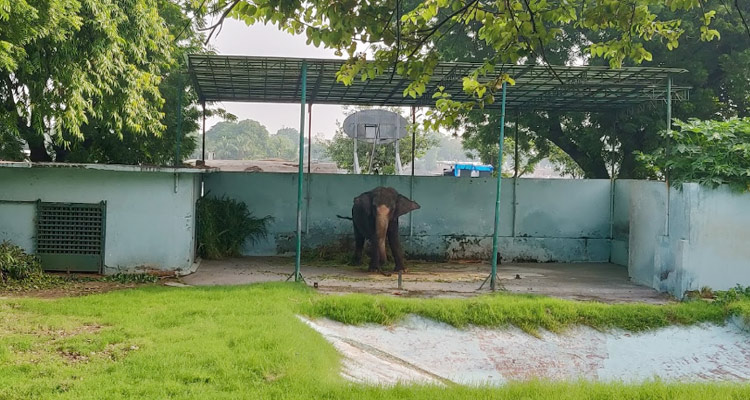
Kamlanehru Zoo, Kankaria
Established in 1951, Kamla Nehru Zoological Garden is situated on the outer periphery of Kankaria Lake and spread over an area of 117 acres. More than 20 lakh visitors visit every year and this number is growing. Within its confines, it houses some of the rare species of the mammals, birds and reptiles, What sets it apart from other Zoological gardens is the personal touch by the devoted zoo staff under the able guidance of the officer incharge and continued support of the Ahmedabad Municipal Corporation making it a home away from the home for its residants.
The Kamla Nehru Zoological Garden, popularly known as Kankaria Zoo, is a 117-acre zoo located on the outer periphery of Kankaria Lake in Ahmedabad, Gujarat. Established in 1951, the zoo is home to various Indian species of animals, birds, and reptiles.
Details:
- Location: Kankaria, Ahmedabad, Gujarat
- Spread: 117 acres
- Animals: Over 450 mammals, 2,000 birds, 140 reptiles
- Breeding Records: Rare species like pythons, crocodiles, bears, and wild donkeys
- Established: 1951
- Awarded: ‘Best Zoo of Asia’ in 1974
Interesting Facts:
- The zoo is situated on the outer periphery of Kankaria Lake, making it a unique and scenic spot.
- The zoo has a personal touch, with devoted zoo staff under the able guidance of the officer-in-charge and continued support from the Ahmedabad Municipal Corporation.
- The zoo is home to over 20 lakh visitors every year, with the number growing each year.
- The zoo has a musical fountain and boating section, making it a fun place to visit.
Indroda Dinosaur and Fossil Park
Indroda Dinosaur and Fossil Park is a precious treasure spread over an area of about 400 hectares on either bank of Sabarmati river in Gandhinagar, the capital of Gujarat. Indroda Park is regarded as India’s Jurrasic Park, it is run by the Gujarat Ecological Education and Research Foundation (GEER), and is one of the only two dinosaur museums in the country.
The Indroda Dinosaur and Fossil Park is a unique attraction located in Gandhinagar, Gujarat, India. Here are some key details about the park:
- Location: The park is situated on the bank of the Sabarmati river, covering an area of 400 hectares of land.
- Status: The park is operating and open to visitors throughout the year.
- Owner: The park is managed by the Gujarat Ecological and Research Foundation (GEER).
- Theme: The theme of the park is science education and entertainment.
- Operating Season: The park is open year-round.
- Area: The park covers an area of 400 hectares (990 acres).
The Indroda Dinosaur and Fossil Park is considered the second-largest hatchery of dinosaur eggs in the world and is often referred to as India’s Jurassic Park. The park houses fossilized remains and petrified eggs of dinosaurs, making it a fascinating destination for science enthusiasts and nature lovers.
Address: Amarapur Village, Nr. Amarnath Dham, Gram Bharati Cross Road Gandhinagar-Mahudi Highway, (Gujarat)-382735, India
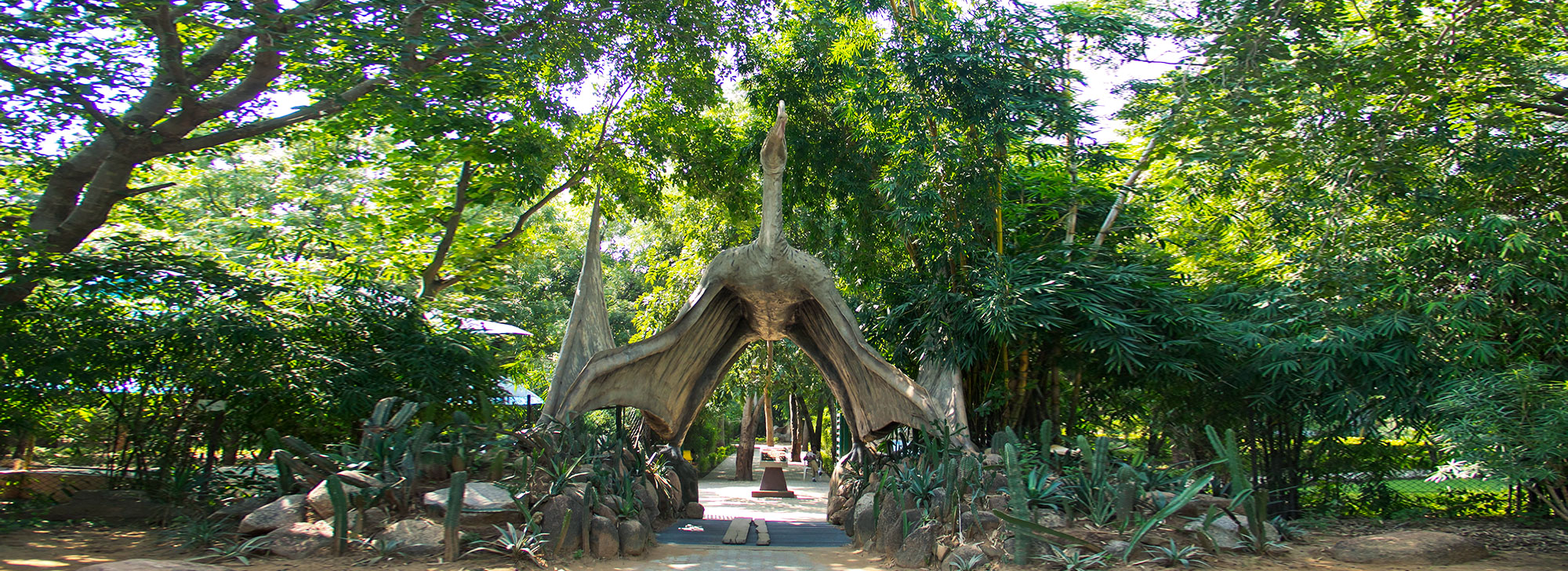
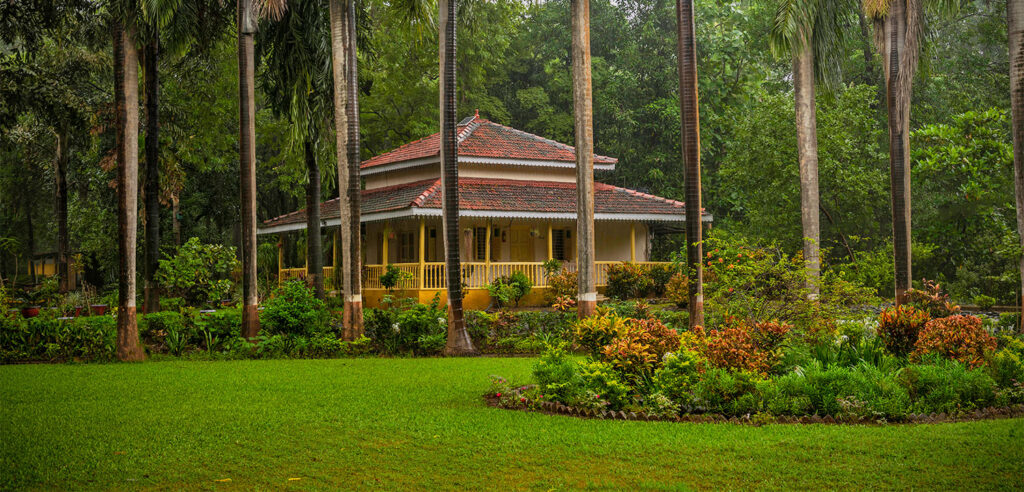
Waghai Botanical Garden
2 km past Waghai, the nearest town, the garden and Bio-Diversity Conservation center have a wide range of native and exotic plant samples from which you can learn to identify plants, learn how they are used for food and medicine, and how much we depend on them. There is a nature education trail which leads you to and from Vansda Park.
Located near Waghai on Waghai-Saputara Road in Dangs District, Gujarat, this botanical garden is the largest in the state, spanning over 24 hectares of land. The garden has a systematic network of roads with a stretch of 7 km in length.
Features
- Floral safari: an android-based program providing information on the scientific details of plants, including local name, family, origin, and medicinal uses.
- Audio Guide: offering visitors a captivating experience with three distinct routes, each narrated in three languages, providing insights into the medicinal properties, historical context, and mythological significance of plant species.
Waghai Botanical Garden is a must-visit destination in Gujarat, offering a unique experience with its vast collection of plant species, audio guide, and floral safari program. Visitors can explore the garden’s natural beauty while uncovering the rich tapestry of stories surrounding the botanical wonders.
Cactus Garden
The Cactus Garden is a unique botanical garden at the Statue of Unity site, created to exhibit a huge variety of Cacti and succulents, the true miracles of adaptation. The thought behind the development of the cactus garden is to provide an experience of the desert ecosystem in the midst of a landmass well entrenched in an aquatic surrounding.
There are 6 lakh plants of 450 species spread across 25 acres of open land and inside the dome having an area of 836 square metres.
A Spectacle Galore: A grand architectural greenhouse, is an ecological habitat of nearly 450 national and international species of cacti and succulent plants. These cacti and succulent species represent their origin in 17 countries of the world mainly from North & South America and African continents. Beautiful rockery showcases distinct flora in its richness. The garden is a ravishing landscape of colourful cacti and succulent plants and also an educational and learning opportunity for students and enthusiasts to explore the nature’s wisdom.
Origination: It is believed that all succulent plants evolved from other related plants growing in a normal environment by adaptation to changing climatic condition of their habitat, especially the irregularity and amount of rainfall. Most of the cacti are American in origin and distributed over vast areas particularly in warm and dry regions.
Salient Features of Cactus Garden:
Solar panel of 8 KW
Nursery for producing succulents and grafted cacti
Erosion control blankets installed for preventing soil erosion
Species & Plants at Cactus Garden:
Total Number of plants: 6.0 lacs
Cactus Plants: 1.9 lacs & Succulent Plants: 1.6 lacs
Ornamental Plants: 2.5 lacs
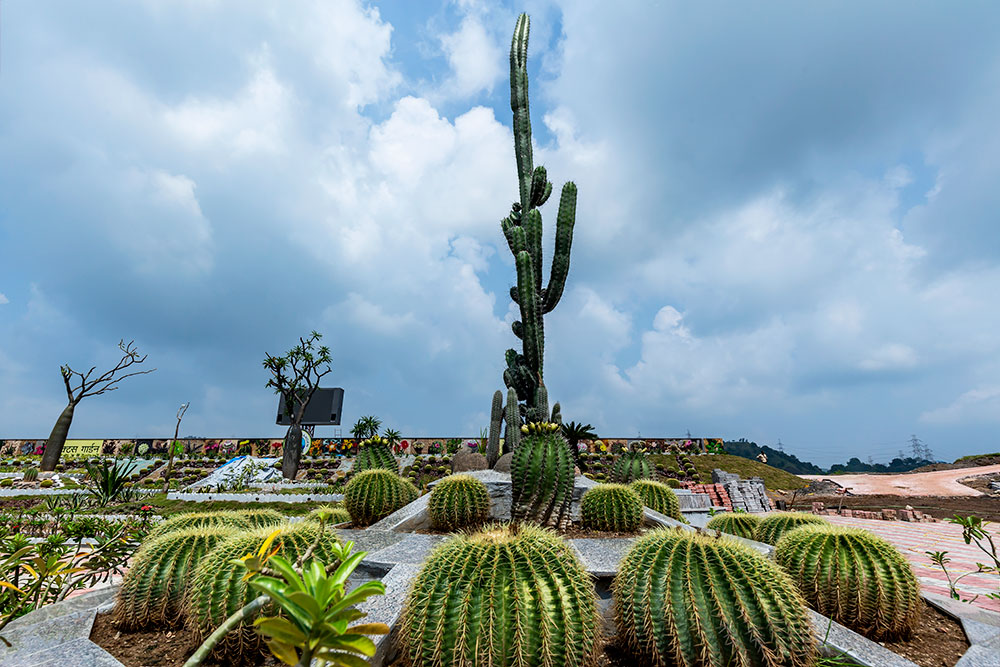

Butterfly Garden
The Butterfly Garden along the banks of Narmada river, makes it an attractive spot to appreciate the assortment of these flying jewels.
The garden harbours more than 70 species of butterflies. The garden is covering 10 acres of area with 150 species of nectar plants and larval host plants. Special care has been taken in the landscaping of the park to support the diversity of butterfly species.
The Butterfly Garden has been developed in a way to create an environment that attracts butterflies and gives them a habitat to proliferate. Since butterflies feed on the nectar of flowers, there are hundreds of flowering plants that will provide them with food.
The Butterfly Garden in Gujarat is a popular tourist attraction that offers a unique experience for visitors. Here are some key details about the garden:
- Location: The Butterfly Garden is located in Kevadiya, near the Statue of Unity, on the bank of River Narmada.
- Area: The garden covers an area of 10 acres and is home to over 70 species of butterflies.
- Nectar Plants: The garden has 150 species of nectar plants and larval host plants that cater to the needs of the butterflies.
- Landscaping: The park’s landscaping is designed to support the diversity of butterfly species, making it a haven for these beautiful creatures.
- Best Time to Visit: The best time to visit the Butterfly Garden is during the day, especially during the peak butterfly season.
Other Butterfly Gardens in Gujarat
- Vadodara: The Butterfly Garden in Vadodara is an arboretum that is home to a diverse range of butterfly species. It is a popular spot for nature lovers and photographers.
- Ahmedabad: The Butterfly Garden in Ahmedabad is a beautiful garden with a lake and a gallery that showcases the different variations of butterflies. It is a popular spot for couples and nature enthusiasts.
Tips for Visiting the Butterfly Garden
- Plan Your Visit: Plan your visit during the day, especially during the peak butterfly season.
- Wear Comfortable Shoes: Wear comfortable shoes as you will be walking around the garden.
- Bring a Camera: Bring a camera to capture the beauty of the butterflies and the garden.
- Be Patient: Be patient and observe the butterflies carefully to spot different species.
Overall, the Butterfly Garden in Gujarat is a must-visit attraction for nature lovers and those interested in wildlife. With its diverse range of butterfly species and beautiful landscaping, it is a unique and unforgettable experience.
Arogya Van
From prehistoric times, humans have realised the importance of medicinal plants. Modern as well as traditional medicinal systems like Ayurveda, since ancient times, have been using herbs to maintain health, for wellness treatments and therapies like massages, curing certain conditions and preventive treatments.
Recognising the importance of these medicinal plants, Arogya Van (Herbal Garden) is developed near the Statue of Unity, which is spread over an area of about 17 acres. Arogya Van exhibits a wide range of medicinal plants and health-related landscapes. The aim of this attraction at kevadia, is to raise awareness about the important role played by plants in the wellness of human beings. Emphasis is also laid on Yoga, Ayurveda and Meditation for being an integral part of a person’s well-being.
The entry gate of Arogya Van has all 12 postures of Surya Namaskar of human size, to emphasise on the importance of yoga, which is to be practiced daily for healthy living. Digital information centre has been set-up to acknowledge visitors and make them understand the heritage and the importance of medicinal plants in our day to day life.
The key highlight at Arogya Van is the ‘Aushadh Manav.’ This is a giant three-dimensional layout of a human body in a resting posture. Each human organ is represented by a medicinal plant that is beneficial for that particular organ. So these plants are planted on the specific part of the body to make the visitors understand the specific plants used for therapeutic treatment of that particular organ.
There are five gardens inside Arogya Van – Garden of Colours, Aroma Garden, Yoga Garden, Alba Garden and Leutea Garden.
Indoor plants section has been created to spread awareness regarding the importance of interior landscape. Interior landscaping plays a vital role in 2 providing a pleasant and tranquil environment in which one can walk and relax. It is a semi-covered fabricated structure. Also to explore the wisdom of traditional healing in its true form at Arogya Van.
Gujarat Forest Department has joined hands with Santhigiri Ashram from Kerala, an organization with more than 60 years of experience in the ancient treatment systems of Ayurveda, Siddha & Yoga. This venture caters to a holistic healthcare based on Ayurveda, Siddha, Panchakarma, Yoga, Marma & Naturopathy to the visitors from India and abroad. Therefore, come and experience the true traditional treatments at the serene atmosphere of Narmada valley at Arogya Van-Santhigiri Wellness Centre.
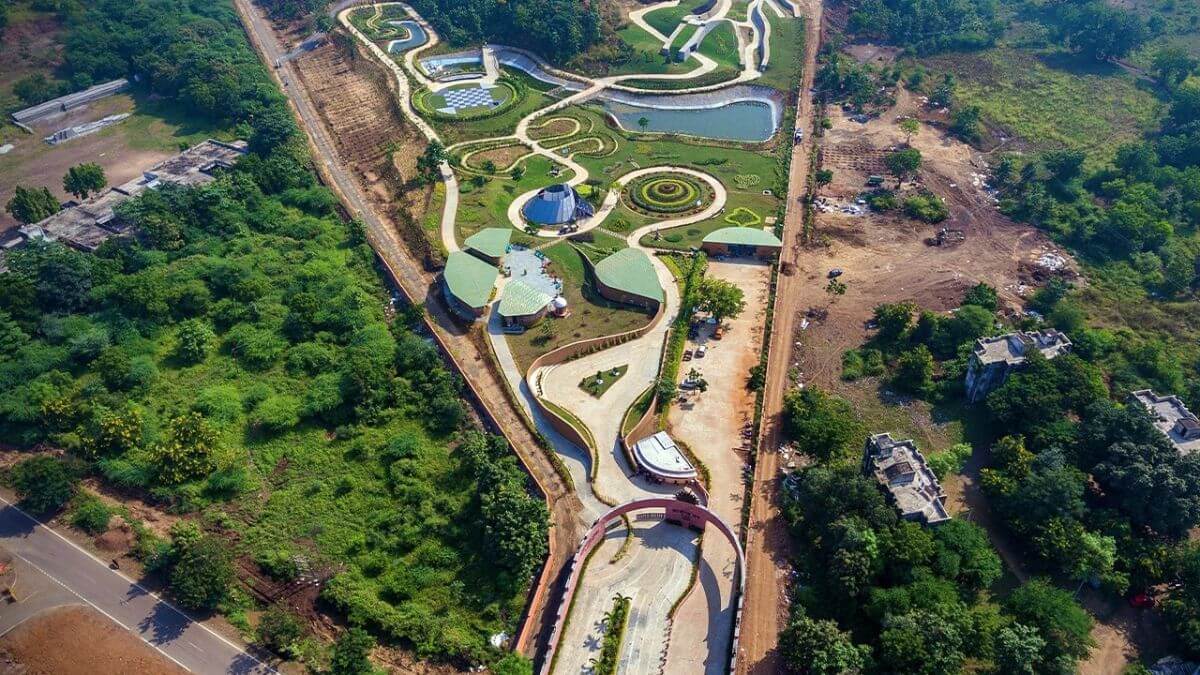

Ekta Nursery
Ekta Nursery was envisioned by the Hon’ble Prime Minister of India, Shri Narendra Modi, while dedicating the Statue of Unity to the Nation. He suggested of developing this Ekta Nursery as a tourist destination to spread awareness about eco-friendly practices.
This nursery serves dual purposes of serving as an educational cum demonstration centre for tourists and providing employment to local people. Ekta Nursery yields one million plants, signifying the underlying theme of Unity pervading across Kevadia.
Ekta Handicrafts: Tourists can experience making of Bamboo Crafts, Areca Leaf Utensils and Organic Pots live, and can purchase them too, along with Ekta plants. This is a Demonstration cum Sale Unit.
Bamboo Craft: Be a part of the cause, save the environment by being a conscious consumer.
Areca Leaf Utensils: Areca leaf utensils are biodegradable and ecofriendly products made from the leaves shed by areca palm trees.
Organic Pots: Experience endless joy of making environment friendly biodegradable pots. o Bonsai: A Bonsai-making training and display area has been created with a view to exposing the visitors with the fascinating art of creating miniatures of the forest giants. Other Attractions:
Hydroponics (soil less farming): A unit has been setup to promote novel technologies in farming. o Honey Bees: An Apiary has been established to exhibit and highlight the role of Honey Bees, which not only provide us with honey but have a remarkable role to play in eco system as pollinators.
Kadaknath: Kadaknath is a black colour chicken, with meat and blood black in colour. Found only in India, it has now also got a Geographical Indication (GI) tag. It is rich in protein (25% higher than any chicken breed), rich in minerals like niacin, protein, fat, calcium, nicotinic, iron, and acid and vitamins B1, B2, B6, B12, C and E and has low fat 5 content. Kadaknath meat is used for treating nervous disorder while its blood is used for treating chronic diseases.
The central part of nursery is dedicated to displaying the ethnic tribal culture of the region. A tribal hut containing various artifacts used by the locals depicts the native culture to the visitors. Souvenir shops have been set up and are run by Gujarat Forest Development Corporation and Cottage & Rural Industries Department.
A Cafeteria has been set to cater the tourists with fabulous tribal delicacies, especially the Herbal Tribal Tea – a unique beverage of this region. Most of the activities here are conducted by women self-help groups belonging to villages around Kevadia. This initiative contributes to employment of local people and is a contributor to the cause of social upliftment.
Moreover, the site is exceptionally picturesque, situated in the valley formed by the majestic Vindyachal and Satpuda mountain ranges, along the banks of Narmada river. The aesthetic exquisiteness can only be experienced rather than told. The breath-taking view of the world’s tallest statue can be seen from the viewing point at the nursery.
Sneh Rashmi Botanical Garden
Sneh Rashmi Botanical Garden is located on the bank of the Tapi river in Surat. Surat – the industrial hub of Gujarat, also has a pleasant and green side to it. The city, which is also called Manchester of India is home to the Botanical Garden of India that has more than 1,000 plant species along with other attraction such as a toy train, Columbus, Injector, Free Fall Jump, Rocket Space, Crazy Jump and hot air balloon ride to enjoy the picturesque Surat.
Location: The Sneh Rashmi Botanical Garden is situated in Surat, Gujarat.
Description: This botanical garden is a beautiful and peaceful place with a variety of plant and flower species. It also features a pond, picnic spots, and a toy train ride.
Reviews and Ratings: The garden has an average rating of 4.5 out of 5 stars based on 39 reviews. Reviewers have praised the garden’s cleanliness, beauty, and peaceful atmosphere. Some have noted that it could be improved with more advertising and food stalls.
Summary of Reviews: The garden is a lovely spot for relaxation and enjoyment, with many visitors appreciating its cleanliness and beauty. While some reviewers have suggested that it could be improved, the overall consensus is that it is a great place to visit.
Other Information: The garden has an entry fee of 10 rupees and offers hot air balloon rides and other attractions. It is a popular spot for photography and picnics.
Useful Information: The garden is a great place to visit for nature lovers, families, and those looking for a peaceful atmosphere. It is also a good spot for photography and picnics.
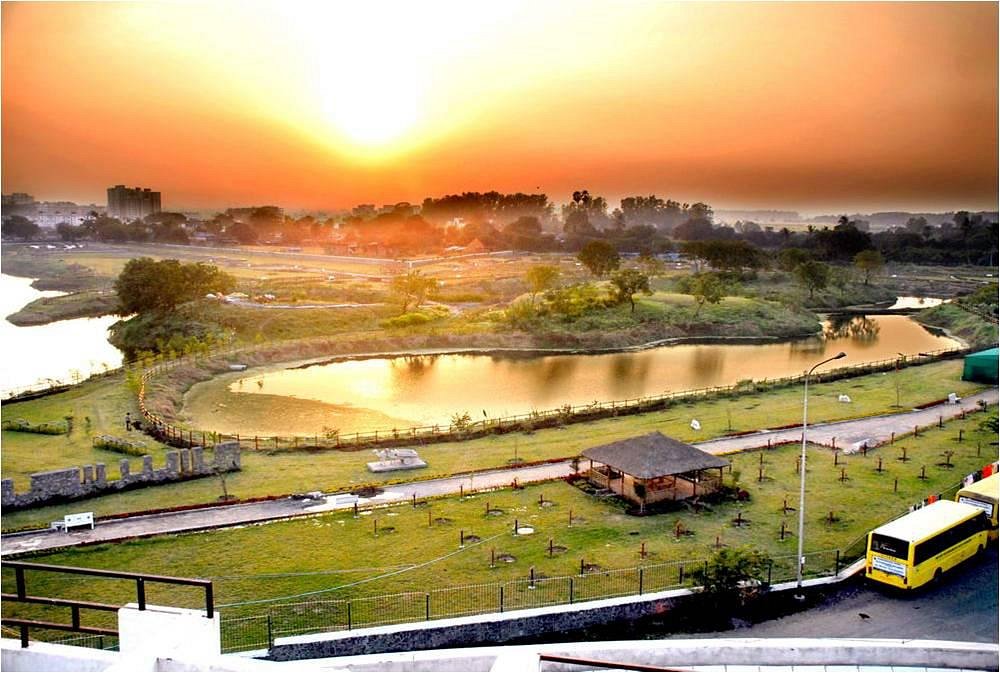
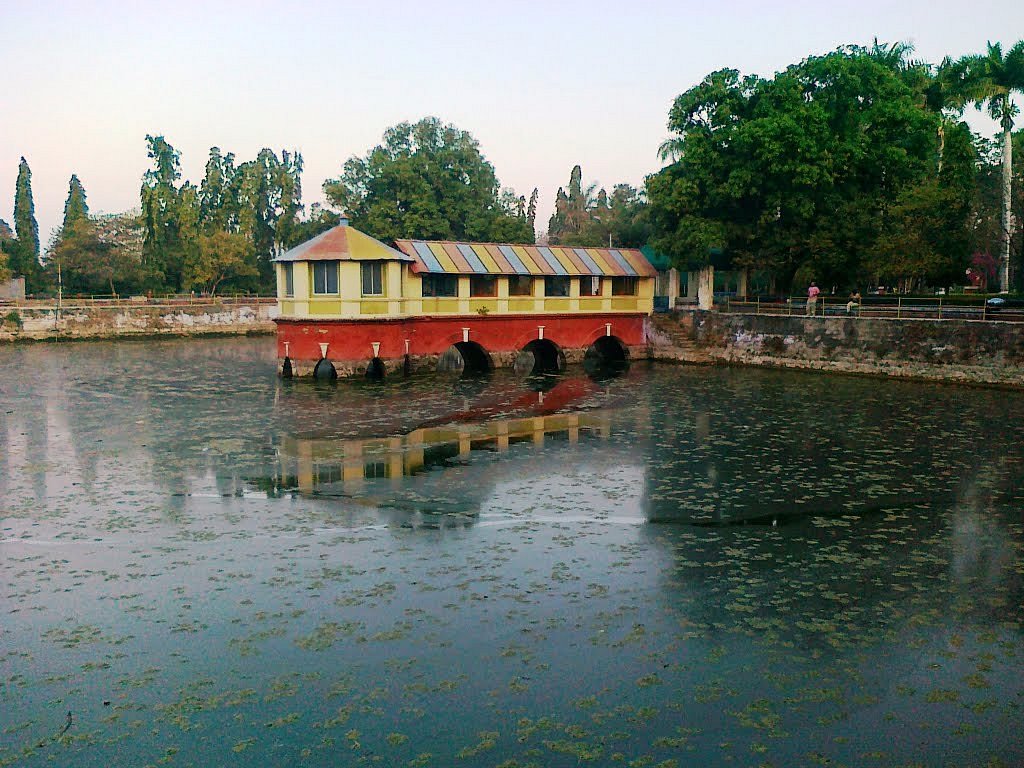
Moti Baug
Moti Baug is a beautiful botanical garden located in the premises of Junagadh Agricultural University, Gujarat. It is a popular tourist destination known for its lush greenery, colorful flora, and serene surroundings.
Moti Baug is situated approximately 3 km from Junagadh Junction, making it easily accessible by road. Visitors can take ST and private buses from other cities in Gujarat to reach Junagadh and then take an auto rickshaw or tonga to reach the garden.
Attractions and Activities
The garden is spread across an area of 2,485 hectares, including the campus of the Agricultural University of Junagadh and Botanical Garden. Visitors can enjoy a relaxing walk or jog amidst the beautiful surroundings, which include a pond, banyan trees, and other dense flora. The garden also has play areas and sitting spaces where visitors can spend quality time with family and friends.
Best Time to Visit
The best time to visit Moti Baug is during the winter months, when the weather is cool and pleasant. The garden is open to visitors throughout the year, but the winter season is ideal for a peaceful and enjoyable visit.
Entry Fee and Timings
The entry fee for Moti Baug is not specified, but visitors can check with the university authorities or local tourist information centers for more information. The garden is open to visitors during daylight hours, but the exact timings may vary depending on the season and weather conditions.
Overall Experience
Moti Baug is a wonderful place to visit in Junagadh, offering a unique blend of natural beauty, relaxation, and recreation. With its lush greenery, colorful flora, and serene surroundings, it is an ideal destination for nature lovers, families, and friends.
Mangalya Van
Nestled atop a hillock i.e. Kailash tekri around a kilometer and half from the Ambaji Temple on the Khedbrahma Highway is Mangalya Van, a unique garden that is of late drawing hordes of tourists. One has to climb steps to reach Kailash tekri and Mangalya Van, which is also surrounded by water bodies. The van was developed by the forest department and its USP is a unique Rashi Van’ (astrological garden) within and a garden of plants, which astrologers say have the same effect as stones on one’s life.
All those who come to Mangalya Van invariably enquire about the effects of plants on sun signs and want to take back home a sapling that favors their zodiac sign. They grow it in their backyard or the vicinity of their house. Around 700 to 800 people visit Mangalya Van every day and on holidays, the number crosses 1,000. Its popularity is picking up fast. Each of the 12 zodiac signs have been given three plants and are planted in 18×18 meter in this garden.
